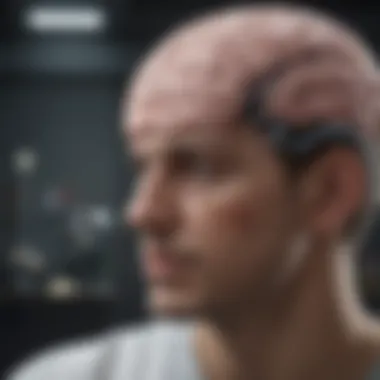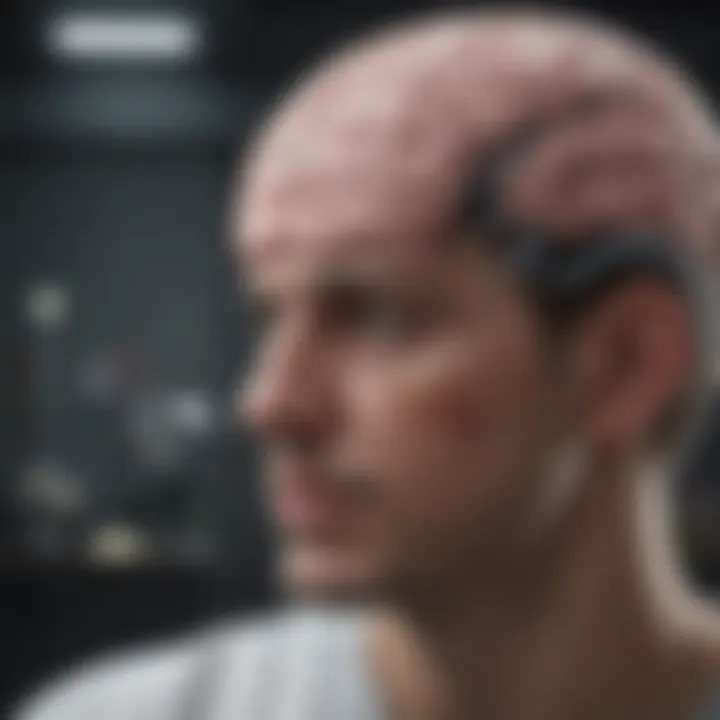Understanding Brain Damage: Causes, Effects, and Rehabilitation


Intro
Brain damage is a significant public health concern that affects a wide variety of individuals, transcending age, gender, and socio-economic status. Understanding this complex issue involves delving deeply into its causes, types, symptoms, and various impacts on personal and societal levels. Brain injuries can diminish cognitive functions, hinder emotional responses, and present obstacles to rehabilitation.
The relevance of this topic becomes clear when considering the staggering number of people affected. According to global health data, millions suffer from conditions resulting from traumatic brain injuries, strokes, and degenerative diseases. As society becomes more aware of neuroanatomy and neurological health, it is essential that both academic and non-academic audiences grasp the intricacies of brain damage, its ramifications, and potential paths for recovery.
This exploration aims to illuminate the foundational aspects of brain damage, prioritizing clarity and accessibility. We seek to raise awareness, foster understanding, and guide further research in the field.
Definition of Brain Damage
Understanding brain damage is crucial in grasping the full impact it has on individuals, families, and society as a whole. This section delves into the essence of what brain damage actually means, both from a medical standpoint and in everyday terms. By clearly defining this concept, readers can better appreciate the scope of the issues related to brain injuries and their outcomes. The definition serves as a foundational element for further exploration of causes, symptoms, and rehabilitation strategies.
Medical Perspective
From a medical point of view, brain damage refers to any injury that disrupts the normal functioning of the brain. This can be due to a variety of factors including trauma, disease, or lack of oxygen.
Commonly, medical practitioners classify brain damage as either primary or secondary. Primary brain damage occurs at the moment of injury, such as in the case of a concussion or a stroke. Secondary brain damage can arise later as a consequence of primary damage. For example, swelling, bleeding, or infection can worsen the original condition and lead to further complications.
Understanding the precise nature of brain damage involves utilizing medical imaging techniques such as CT scans and MRIs. These tools allow healthcare professionals to visualize the extent of the damage and tailor interventions appropriately. Ultimately, recognizing brain damage in a medical context enables accurate diagnosis and effective treatment strategies that are essential for recovery.
Layman's Understanding
In simpler terms, brain damage can be understood as any sort of impairment or injury to the brain that affects someone's ability to think clearly, move their body, or control their emotions. It can occur from an accident like a fall or from illnesses such as dementia.
People without medical training may describe brain damage in a variety of ways. Some might refer to it as "getting knocked out" or "having a stroke"; others may emphasize changes in personality or behavior as indicators. Regardless of the phrasing, the fundamental takeaway is that brain damage can significantly alter how a person experiences life.
For families and friends, recognizing signs of brain damage in a loved one can be distressing. Symptoms often include confusion, memory issues, or sudden emotional changes. Clarifying what brain damage means in day-to-day terms fosters better communication and understanding among those affected.
"Understanding brain damage from both medical and lay perspectives allows for a more comprehensive view of its impact on a person’s life."
Grasping the definition of brain damage sets the stage for a deeper conversation about its causes, symptoms, and rehabilitation options. This foundational knowledge is pivotal for anyone looking to support individuals navigating the challenges of brain injury.
Causes of Brain Damage
Understanding the causes of brain damage is essential in grasping how various factors contribute to injury. Brain damage can arise from an array of origins, each carrying its own implications for diagnosis and treatment. Identifying these causes allows for more effective interventions and prevention strategies. Knowing the etiology also aids families and healthcare providers in providing necessary support.
Traumatic Injuries
Concussions
Concussions are a common type of brain injury. They often result from a blow to the head or a violent shaking of the head and body. This type of injury leads to a temporary disruption of brain function, with various symptoms such as headache, confusion, dizziness, and even memory loss. The significant aspect of concussions is their prevalence in contact sports. It is a notable choice in research as they highlight the need for preventive measures and awareness in athletics. The main disadvantage is the risk of recurrent concussions, which can lead to more severe long-term consequences.
Contusions
Contusions refer to bruises on the brain tissue itself, usually resulting from a direct impact to the head. Unlike concussions, which are functional disruptions, contusions involve actual physical damage to brain tissue. Their importance lies in the fact these injuries can cause swelling and increased pressure within the skull. They are significant in understanding the complexity of brain injuries because they underscore the need for monitoring and potential surgical intervention. The disadvantage is that recovery tends to be more prolonged, often requiring intensive rehabilitation.
Penetrating Injuries
Penetrating injuries occur when an object breaches the skull and enters brain tissue. This could be due to gunshot wounds or sharp objects. The distinctive aspect of penetrating injuries is that they can cause immediate and irreversible damage to the brain. These injuries contribute to a deeper understanding of how both structural damage and loss of brain function can occur simultaneously. The advantage is that they offer clear insights into brain function based on the area affected. However, they often result in devastating outcomes, including significant cognitive and physical impairments.
Non-Traumatic Factors
Stroke
A stroke happens when blood flow to a part of the brain is interrupted. This can be due to a blocked artery (ischemic stroke) or bleeding (hemorrhagic stroke). Strokes are a leading cause of brain damage and disability worldwide, making them a critical focus in medical research. Their main characteristic is the rapid onset of symptoms, which emphasizes the urgency for medical intervention. The unique feature is the availability of treatments that can minimize damage if administered promptly. However, recovery can still be challenging, and long-term outcomes can vary widely.
Anoxia
Anoxia refers to a lack of oxygen supply to the brain. Causes may include suffocation or drowning. The critical aspect of anoxia is its potential to cause widespread brain damage quickly. Understanding this condition is vital because it informs the treatment pathways that can save brain tissue in certain circumstances. The drawback is that with prolonged anoxia, recovery can be limited, often resulting in severe impairments.
Multiple Sclerosis
Multiple sclerosis is a chronic disease that affects the central nervous system, causing damage to the protective myelin sheath of nerve fibers. Its contribution to brain damage is notable as it illustrates how autoimmune responses can disrupt brain function over time. Its unique aspect is that it often leads to a range of neurological symptoms, making it a complex condition to address in the healthcare system. One disadvantage is the unpredictable nature of the disease progression, which complicates treatment and rehabilitation strategies.
Infectious Diseases
Meningitis


Meningitis is an infection that causes inflammation of the membranes surrounding the brain and spinal cord. This condition can lead to serious complications, including brain damage if not treated promptly. The significant aspect of meningitis is how quickly it can lead to critical health issues, emphasizing the importance of early recognition and treatment. Its unique feature lies in the fact that it can be viral or bacterial, with bacterial meningitis being far more severe. On the downside, it can still cause long-term cognitive and physical disabilities, affecting quality of life.
Encephalitis
Encephalitis involves the inflammation of the brain itself, often due to a viral infection. This condition can lead to extensive neurological damage. The important characteristic of encephalitis is the potential for rapid onset of symptoms, necessitating swift medical intervention. Its unique aspect is the wide variety of viruses that can cause it, which makes clinical management challenging. The disadvantage is that some patients may experience recurrent symptoms, complicating their long-term recovery.
Toxic Substances
Alcohol
Alcohol consumption can lead to brain damage, especially with chronic use. This phenomenon occurs as alcohol affects neurotransmission and can lead to a variety of cognitive impairments. The essential characteristic of alcohol-related brain damage is its gradual onset, which emphasizes the importance of early intervention. Its unique feature is that certain populations, such as those with drinking problems, are at higher risk for significant impairments. However, abstaining from alcohol can often result in improved brain health over time, making it an important aspect of recovery strategies.
Drug Overdose
Drug overdose can cause acute and potentially life-threatening brain damage. This can happen through various substances, including opioids, stimulants, or sedatives. The key aspect of drug overdose is the immediate risk of mortality and the extensive care required post-event. This situation is essential for understanding the broader implications of substance abuse on public health. The unique feature lies in the fact that recovery can be complex, often requiring multi-faceted treatment plans that address both physical and psychological needs. However, the path to recovery can be long and fraught with challenges.
Types of Brain Damage
Understanding the types of brain damage is crucial. This knowledge is fundamental in evaluating the nature and extent of damage caused by various factors. Distinguishing between acquired and congenital brain injuries is essential for effective diagnosis, treatment, and rehabilitation. Knowing the origin of the brain injury aids healthcare professionals in creating tailored recovery plans. Furthermore, it can help families and caregivers manage care effectively.
Acquired Brain Injury
Acquired brain injury occurs after birth. This means that individuals were born with a healthy brain, but an event caused damage later in life. Common causes include traumatic injuries, strokes, and infections.
- Traumatic Brain Injury (TBI): This can result from external forces like falls, car accidents, or violence. A concussion from sports falls under this category.
- Stroke: Blood flow to the brain is interrupted, leading to cell death. Individuals can experience various physical disabilities or cognitive impairments.
- Infections: Conditions affecting the brain, like meningitis, can also lead to acquired brain injury.
Each case of acquired brain injury comes with unique challenges. Those who suffer from it often face long-term effects, making understanding and preventive measures essential.
Congenital Brain Damage
Congenital brain damage happens during fetal development. It can result from genetic factors, environmental influences, or complications during pregnancy or birth.
Common conditions related to congenital brain damage include:
- Cerebral Palsy: A group of disorders affecting movement and muscle tone, often arising from brain injury during pregnancy or childbirth.
- Spina Bifida: A serious birth defect that occurs when the spine does not close completely. This condition can impact the brain and nervous system.
- Genetic Disorders: Certain inherited conditions can lead to brain damage before or at birth.
The effects of congenital brain damage often last a lifetime. Early intervention is critical for improving quality of life. Understanding congenital damage helps guide prenatal care and counseling for expecting parents.
Symptoms of Brain Damage
Understanding the symptoms of brain damage is crucial for recognizing its impact on individuals, families, and society. Symptoms can vary significantly based on the area of the brain affected and the severity of the damage. By identifying these symptoms early, caregivers and healthcare professionals can provide timely support and interventions. This section sheds light on various cognitive, emotional, and physical symptoms that arise due to brain damage.
Cognitive Impairments
Cognitive impairments manifest as challenges in thinking, learning, and memory. These impairments can considerably affect daily functioning and quality of life.
Memory Loss
Memory loss is a significant symptom of brain damage. It can range from minor forgetfulness to profound amnesia. This loss can notably hinder personal, social, and occupational functioning. A key characteristic of memory loss is its unpredictable nature; some individuals may forget daily tasks while retaining long-term memories. Including memory loss in this article offers insights into an aspect that profoundly affects interpersonal relationships and self-identity. The unique feature of memory loss is its ability to create barriers in communication and social interaction, leading to isolation. The disadvantage here is that while some therapies aim to improve memory retention, results can vary widely among individuals.
Difficulty Concentrating
Difficulty concentrating is another common cognitive symptom. Individuals may find focusing on tasks challenging, leading to decreased productivity. This aspect is significant in understanding brain damage, as the ability to concentrate is tied to overall cognitive function. A key characteristic of this symptom is its effect on multitasking abilities and sustained attention over time. Highlighting difficulty concentrating is beneficial to this article as it sheds light on how this symptom affects learning and everyday responsibilities. Its unique feature lies in the frustration it can cause, as people struggle with tasks they once performed easily. The disadvantage is that strategies to improve concentration often require tailored approaches and can necessitate ongoing support.
Emotional and Behavioral Changes
Brain damage can lead to emotional and behavioral changes that impact both the individual and those around them.
Depression
Depression is a prevalent emotional response to brain damage. Individuals may experience feelings of sadness, hopelessness, and a loss of interest in activities. A defining characteristic is the potential for this depression to fluctuate based on the individual's condition. This article considers depression important because it not only affects mental well-being but can also impair recovery and rehabilitation efforts. The unique feature of depression is its interaction with cognitive impairments, creating a cycle that negatively reinforces each condition. The disadvantage is that untreated depression can lead to further deterioration of both mental and physical health, complicating recovery efforts.
Personality Changes
Personality changes can occur following brain injury, affecting how individuals interact with others. These changes may include irritability, impulsivity, or apathy. A key characteristic is that these changes may not align with the person’s pre-injury self, leading to confusion for loved ones. Including personality changes in this article provides a comprehensive view of how brain damage does not just affect cognitive function but also alters social interactions. The unique feature of these changes may lead to strained relationships and isolation as family and friends adjust to the new dynamics. The disadvantage is that these changes can sometimes be misinterpreted, leading to misunderstandings or lack of support.
Physical Effects


The physical effects of brain damage can significantly impair daily activities and overall independence.
Motor Function Loss
Motor function loss involves difficulty with movement and coordination, affecting one’s ability to walk, balance, or perform fine motor tasks. A key characteristic is the specific body parts affected, which can vary, causing diverse functional challenges. Examining motor function loss is essential for this article as it emphasizes the tangible impact of brain damage on personal autonomy. The unique feature is that recovery often entails long therapy and adaptation periods. The disadvantage is that physical limitations can trigger frustration and emotional distress, complicating rehabilitation.
Seizures
Seizures are another physical manifestation that may arise from brain damage. They can range from mild episodes to severe convulsions. A key characteristic of seizures is their unpredictability, which can impose significant lifestyle changes on individuals. Discussing seizures here reinforces the discussion on brain damage by highlighting emergencies that may arise and their potential to affect the individual’s safety. The unique aspect of seizures is their ability to disrupt everyday activities unexpectedly. However, the disadvantage is that managing seizures often requires ongoing medical intervention and lifestyle adjustments, complicating recovery efforts.
Diagnosis of Brain Damage
The diagnosis of brain damage plays a crucial role in understanding the scope and impact of injury on an individual. Timely identification is essential for suitable intervention, potentially improving outcomes. Accurate diagnosis not only assists in medical treatment but also contributes to the psychological support required for recovery. Moreover, a clear diagnosis informs rehabilitation strategies, ensuring that tailored approaches address specific deficits.
Neurological Examination
A neurological examination is the first step in diagnosing brain damage. This examination assesses various functions of the brain and nervous system, including strength, coordination, reflexes, and sensory perception. It involves careful observation and hands-on testing by healthcare professionals. The results can reveal significant indicators of brain function and health status.
This examination may also involve assessing cognitive functions, such as memory and problem-solving skills. Despite being less invasive than imaging techniques, the neurological examination requires expertise to interpret the results effectively. These results often guide further testing and treatment options.
Imaging Techniques
Imaging techniques are vital for a comprehensive diagnosis of brain damage. They allow for visualization of the brain's structure and potential abnormalities. Among the most commonly used imaging methods are CT scans and MRI.
CT Scans
CT scans, or computed tomography scans, provide detailed cross-sectional images of the brain. This method is quick and widely available in medical facilities. One of the key characteristics of CT scans is their ability to detect bleeding or swelling in the brain, which can occur after traumatic injuries.
CT scans are beneficial as they provide immediate results, critical in emergency situations. However, they come with a disadvantage: exposure to radiation. Despite this, their speed and efficiency make them a popular choice in initial assessments of brain injury.
MRI
MRI, or magnetic resonance imaging, offers a more detailed view of brain structures compared to CT scans. This imaging technique uses magnetic fields and radio waves to produce high-resolution images. One notable characteristic of MRI is its ability to visualize soft tissues better, making it effective for detecting tumors, infections, or degenerative diseases.
MRI is advantageous due to its non-invasive nature and absence of radiation. However, it often takes longer to perform and may not be as readily available as CT scans in all settings. Thus, while MRI provides valuable insights, accessibility and timing must be considered in the diagnosis process.
Cognitive Assessments
Cognitive assessments are instrumental in evaluating the impact of brain damage on mental function. These tests measure various cognitive abilities, such as attention, memory, language skills, and executive functions. Professionals use standardized assessments to determine the extent of impairment and to develop recovery programs.
In summary, the diagnosis of brain damage encompasses several methods that collectively contribute to accurate identification and effective treatment. Neurological examinations, imaging techniques like CT and MRI, and cognitive assessments form a comprehensive diagnostic approach, enabling informed decisions in medical and rehabilitative care.
Impact of Brain Damage
Understanding the impact of brain damage is crucial in grasping the broader implications of such injuries. Brain damage influences various aspects of life, including cognitive functioning, emotional well-being, and overall quality of life. Delving into this subject reveals not only the personal challenges faced by affected individuals but also the effects on their families and society as a whole. The importance of recognizing these impacts cannot be overstated, as they play a significant role in shaping rehabilitation approaches and support systems.
On Individuals
Quality of Life
Quality of life is a critical factor for individuals who have experienced brain damage. It encompasses one’s overall well-being, including emotional, social, and physical aspects. In this context, assessing quality of life helps to understand how brain damage alters life expectations and satisfaction. Affected individuals might face new limitations, altering their ability to engage in everyday activities. This change often leads to feelings of frustration and isolation. The key characteristic of quality of life in this context is adaptability – determining how well an individual adjusts to their new reality can highlight areas needing support. Although improving quality of life is a popular pursuit, it presents challenges. Individuals may require extensive therapy and ongoing support to regain functionality, which can be a lengthy and complex process.
Independence Levels
The level of independence following brain damage is another vital aspect. Independence is directly tied to an individual’s ability to perform daily tasks without assistance. For many, maintaining independence is essential for self-esteem and personal identity. After brain damage, a person's independence may drastically reduce, often leading to dependence on caregivers. This loss can significantly affect emotional well-being. The unique feature of independence levels is their variability; some people may reclaim much of their independence with rehabilitation, while others may struggle more. This fluctuation illustrates the diverse experiences of individuals with brain damage, marking the importance of tailored rehabilitation plans designed around each person's potential for recovery.
On Families
Emotional Burden
The emotional burden on families dealing with brain damage is often profound. Family members may face stress from caring for a loved one while also managing their own emotional responses to the situation. This burden encompasses feelings of grief, anxiety, and frustration, with caregivers often feeling overwhelmed. Understanding emotional burden is essential, as it can lead to discussions about support needs for both the individual and their family members. A central characteristic of this burden is continual adaptation; families must constantly adjust their roles to care for someone who has changed fundamentally. The emotional impacts of this experience can be both negative and positive, as some families report strengthened bonds while others feel strained.
Financial Costs
Brain damage can incur significant financial costs, making it an issue of increasing relevance. The expenses related to medical treatment, rehabilitation, and ongoing care can overwhelm families. Insurance may cover some costs, but often falls short. A critical characteristic of financial costs in brain damage is unpredictability. Costs can escalate unexpectedly, impacting a family’s financial stability. Unique features of these costs include considerations such as lost income for caregivers and the need for specialized equipment, which adds another layer of complexity. This financial burden often exacerbates the emotional strain on families, highlighting the multi-faceted challenges posed by brain damage.
On Society


Economic Impact
The economic impact of brain damage extends beyond individual cases, significantly affecting communities and healthcare systems. Increased healthcare costs, long-term rehabilitation expenses, and loss of productivity create a burden on various levels of society. One key characteristic of economic impact is the strain on public resources, such as healthcare facilities and support services. Addressing brain damage requires funding, which can divert resources from other pressing public health issues. The unique aspect of this economic burden is that it affects not only the families involved but society at large, emphasizing the need for comprehensive strategies for prevention and care.
Public Health Challenges
Public health challenges related to brain damage are immense. This condition highlights gaps in healthcare resources and the need for better support frameworks. A key characteristic of public health challenges is the increasing demand for specialized services due to rising incidences of brain damage from conditions like strokes and accidents. Understanding these challenges is vital as they help shape policies aimed at improving prevention and care strategies. A unique feature of public health concerns in brain damage is that they often intersect with broader health issues, such as mental health services, creating a complex web of needs that policymakers must address.
Overall, understanding the impact of brain damage is essential for improving individual lives and building stronger support systems within families and communities.
Rehabilitation and Therapy
Rehabilitation and therapy play a crucial role in the recovery process for individuals who have experienced brain damage. This phase not only aims to restore lost functions but also seeks to improve overall quality of life. Effective rehabilitation requires a personalized approach, taking into account each individual's specific needs and circumstances. The process can be lengthy, involving various professionals and methods, but the benefits are substantial. Patients can regain independence, rebuild their self-esteem, and achieve a greater level of functioning in daily life.
Physical Therapy
Physical therapy is a foundational component of rehabilitation for brain damage patients. This therapy focuses on restoring movement and strength through targeted exercises and activities. The goal is to improve physical capabilities that may have been affected by the injury.
Therapists often employ several techniques, including:
- Strength training: Enhancing muscle strength to support mobility.
- Balance exercises: Improving stability to reduce the risk of falls.
- Coordination tasks: Facilitating better control over body movements.
By progressively challenging patients, physical therapy enables them to regain confidence in their physical abilities. Importantly, therapists monitor progress, adapting exercises as needed to ensure patients are not overwhelmed while working towards their goals.
Occupational Therapy
Occupational therapy provides another dimension to rehabilitation, focusing on helping patients engage in daily activities or occupations. This may involve adapting tasks or environments to facilitate easier completion of these activities.
Key aspects of occupational therapy include:
- Activity modification: Adjusting tasks to match the patient's current abilities.
- Assistive devices: Introducing tools that can aid in everyday tasks, such as adaptive utensils for eating.
- Skill development: Teaching new ways to perform tasks that may have become challenging.
The therapists work closely with patients to set meaningful goals. These may range from personal care tasks to social and recreational activities. The emphasis is on enabling patients to participate in life to the fullest extent possible.
Psychological Support
Psychological support is vital in the rehabilitation process, addressing the emotional and mental health aspects of recovery. Brain damage can significantly alter a person's mental state, often leading to feelings of frustration, sadness, or anxiety. Mental health professionals can offer necessary coping strategies and interventions.
Important elements of psychological support may include:
- Counseling sessions: Providing a safe space for patients to express their feelings and thoughts.
- Support groups: Facilitating peer interactions to share experiences and solutions.
- Cognitive-behavioral techniques: Equipping patients with tools to manage negative thoughts and emotions.
Support also extends to families, which helps encourage a holistic approach toward recovery. Recognizing and addressing the mental aspects of rehabilitation not only fosters better outcomes but also encourages a more supportive environment for overall healing.
Brain damage recovery is not solely about physical healing; it requires a multifaceted approach that includes physical, occupational, and psychological support.
Combining these therapeutic measures creates a comprehensive recovery plan, one that is tailored to the individual's specific challenges and goals. This strategy maximizes the chances of a positive recovery experience.
Future Directions in Research
Research into brain damage is evolving rapidly. This section explores important areas of future investigation, focusing on neuroplasticity and innovations in treatment. Understanding these elements can lead to significant advancements in the recovery process for individuals affected by brain injuries.
Neuroplasticity Studies
Neuroplasticity refers to the brain's ability to adapt and reorganize itself. This phenomenon occurs at multiple levels including cellular and functional adaptations. Understanding neuroplasticity is crucial for developing effective rehabilitation strategies. It offers insights into how the brain can form new connections after damage.
Several studies suggest that engaging in specific therapies enhances neuroplastic responses. This could include physical exercises or cognitive training activities. The aim is to maximize the brain's ability to recover lost functions by encouraging it to create alternative pathways. Furthermore, advancements in neuroimaging technologies allow researchers to visualize these changes in real-time. This provides valuable data on how different treatments influence recovery.
Incorporating neuroplasticity findings into clinical practice can help tailor rehabilitation programs for individuals. Clinicians must consider not only the physiological aspects of brain injury but the brain's inherent ability to adapt. Studies in this field are essential for identifying the best approaches, ultimately leading to more effective therapies and improved outcomes for patients.
Innovations in Treatment
As research progresses, innovations in treatment for brain damage are emerging. These treatments aim to enhance recovery and improve quality of life for patients.
One promising area is the development of pharmacological interventions. New drugs are emerging that target specific pathways involved in brain repair. These can potentially reduce cell death and promote recovery at a cellular level. However, the effectiveness of these drugs must be evaluated through rigorous clinical trials.
Another innovation is the use of technology in rehabilitation. Virtual reality and robotics are beginning to play a vital role in therapy. For instance, robotic-assisted therapy provides precise and repetitive movements, aiding in physical recovery. Similarly, virtual environments can simulate real-world tasks, improving cognitive functions and motor skills.
Moreover, interdisciplinary approaches combining various treatment modalities show promise. Collaborations between neurologists, psychologists, and physiotherapists can create comprehensive interventions tailored to individual needs. This holistic view is crucial for addressing the multifaceted nature of brain damage.
Future advancements in treatment will rely on collaborative efforts across disciplines, integrating technology and a deep understanding of neuroplasticity.
In summary, the future directions in brain damage research point toward a more customized approach in treating patients. Understanding neuroplasticity and embracing technological innovations will provide new pathways for recovery. By focusing on these areas, researchers and clinicians can better support those affected by brain injuries and enhance their recovery journey.



